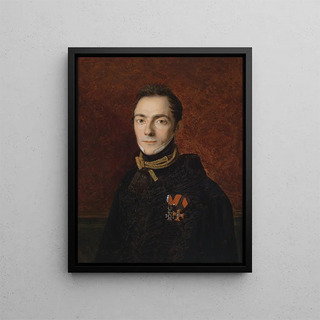Portrait of Count Apponyi - Ferdinand Georg Waldmüller | Art print


View from behind

Frame (optional)
Ferdinand Georg Waldmüller’s "Portrait of Count Apponyi" is much more than a simple depiction of an aristocrat; it is an open window into an era where art and nobility intertwined to create works of unparalleled depth. This painting, imbued with rare elegance, captures the very essence of its subject, revealing not only his outward appearance but also the nuances of his character and social status. Through Waldmüller’s precise brushstrokes, the viewer is invited to delve into the count’s intimate universe, to feel the emotions that inhabit him, and to appreciate the richness of a cultural heritage.
Style and uniqueness of the work
Waldmüller’s technical mastery is evident in every detail of this portrait. His subtle use of light and shadow creates an almost tangible atmosphere, while the textures of clothing and accessories are rendered with remarkable precision. The choice of colors, both vivid and nuanced, helps bring the canvas to life, highlighting the dignity and charisma of Count Apponyi. What truly sets this work apart is the artist’s ability to capture not only the physical appearance but also the soul of his model. The penetrating gaze of the count, combined with a majestic posture, evokes a complex and influential personality rooted in his time. Waldmüller thus manages to transcend the simple portrait to offer a reflection on identity and power.
The artist and his influence
Ferdinand Georg Waldmüller, an emblematic figure of 19th-century Austria, established himself as one of the masters of the art print. His work reflects a period marked by social and political changes, where the individual begins to occupy a central place in art. Waldmüller, through his realistic approach and sensitivity, captured the spirit of his time while influencing many contemporary artists. His style, characterized by meticulous attention to detail and a deep understanding of human emotions, paved the way for new forms of artistic expression. Through portraits such as

Matte finish

View from behind

Frame (optional)
Ferdinand Georg Waldmüller’s "Portrait of Count Apponyi" is much more than a simple depiction of an aristocrat; it is an open window into an era where art and nobility intertwined to create works of unparalleled depth. This painting, imbued with rare elegance, captures the very essence of its subject, revealing not only his outward appearance but also the nuances of his character and social status. Through Waldmüller’s precise brushstrokes, the viewer is invited to delve into the count’s intimate universe, to feel the emotions that inhabit him, and to appreciate the richness of a cultural heritage.
Style and uniqueness of the work
Waldmüller’s technical mastery is evident in every detail of this portrait. His subtle use of light and shadow creates an almost tangible atmosphere, while the textures of clothing and accessories are rendered with remarkable precision. The choice of colors, both vivid and nuanced, helps bring the canvas to life, highlighting the dignity and charisma of Count Apponyi. What truly sets this work apart is the artist’s ability to capture not only the physical appearance but also the soul of his model. The penetrating gaze of the count, combined with a majestic posture, evokes a complex and influential personality rooted in his time. Waldmüller thus manages to transcend the simple portrait to offer a reflection on identity and power.
The artist and his influence
Ferdinand Georg Waldmüller, an emblematic figure of 19th-century Austria, established himself as one of the masters of the art print. His work reflects a period marked by social and political changes, where the individual begins to occupy a central place in art. Waldmüller, through his realistic approach and sensitivity, captured the spirit of his time while influencing many contemporary artists. His style, characterized by meticulous attention to detail and a deep understanding of human emotions, paved the way for new forms of artistic expression. Through portraits such as
12,34 €






